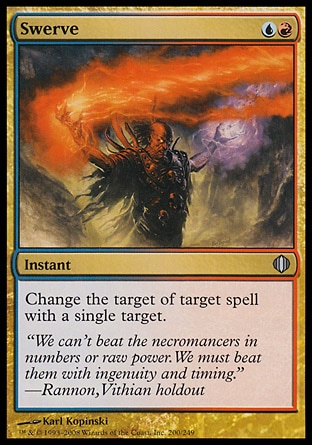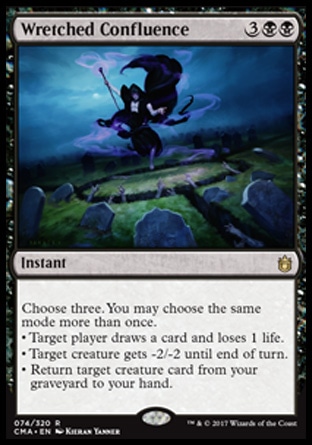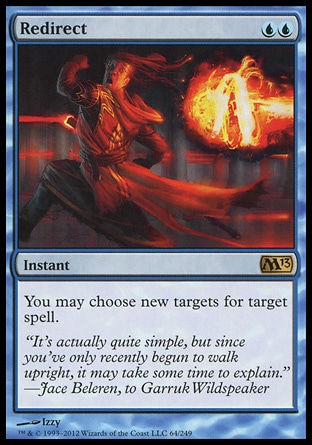Cryptic Command is one of those amazing modal spells that do anything, except maybe fetching you coffee”.
Modal spells
Let us scrutinize modal spells thoroughly. We’ll need a glance into the rules to do that:
Example:
- “Choose one —” in Boros Charm;
- “Choose two —” in Primal Command;
- “Choose one or both —” in Branching Bolt;
- “Choose one or more —” in Clan Defiance;
- “Choose three —” in Mystic Confluence
- or “[certain player] chooses one —” in Misfortune.
Cryptic Command has four modes. Its text allows you to choose any two modes the spell will be played with. You may not choose the same mode twice, they must be different modes:
- Counter target spell;
- This part of the Command’s effect counters target spell. It cannot counter an ability and may not target the Command itself. The countered spell is removed from the stack (usually, the card is moved to the graveyard, but other situations are possible) and has no effect.
- Return target permanent to its owner’s hand;
- This one may target any legal permanent on the battlefield. It doesn’t matter who controls it or what its card type is. It deals even with lands and planeswalkers.
- Tap all creatures your opponents control;
- This part of the Command’s effect does not target opponents! Only the creatures controlled by your opponents as the Command spell resolves are tapped. It doesn’t target creatures either, so it will tap creatures with protection, hexproof and shroud.
- Draw a card.
- If it is the first card you draw this turn, a Miracle can happen.
As the Command resolves, the chosen modes are fulfilled in the order printed on the card. This matters a lot sometimes:
You cast a large scary creature. Your cunning yet not very familiar with the rules opponent responds with Cryptic Command choosing “return target permanent to its owner’s hand” targeting your Leyline of Lifeforce and “counter target spell” targeting the creature spell. The opponent hopes that Leyline of Lifeforce leaves the battlefield, and the effect of its static ability will cease, allowing to counter the creature spell. To his great disappointment, the countering mode is printed on the Command first, so it will be fulfilled first. The opponent’s Command will attempt to counter the creature spell, fail to do so, then bounce our Leyline. The creature spell will then resolve successully.
700.2a. The controller of a modal spell or activated ability chooses the mode(s) as part of casting that spell or activating that ability. If one of the modes would be illegal (due to an inability to choose legal targets, for example), that mode can’t be chosen. (See rule 601.2b.)
700.2b. The controller of a modal triggered ability chooses the mode(s) as part of putting that ability on the stack. If one of the modes would be illegal (due to an inability to choose legal targets, for example), that mode can’t be chosen. If no mode can be chosen, the ability is removed from the stack. (See rule 603.3c.)
A player chooses modes as the spell (or ability) is put onto the stack. After this, the other modes are forgotten — the game doesn’t see them. An illegal mode may not be chosen.
700.2c. If a spell or ability targets one or more targets only if a particular mode is chosen for it, its controller will need to choose those targets only if he or she chose that mode. Otherwise, the spell or ability is treated as though it did not have those targets. (See rule 601.2c.)
This means that as you cast a modal spell, you choose targets only when you have chosen a mode that has targets.

Cryptic Command:
- may have no targets
- if you choose “Tap all creatures your opponents control” and “Draw a card”
- one target
- for example, “Counter target spell” + “Draw a card”
- or two targets
- “Counter target spell” + “Return target permanent to its owner’s hand”
Cryptic Command is a legal target for Swerve only in the second case.
If a spell has targets, they must be legal both when the spell is cast and when it resolves. If all targets become illegal at resolution, it doesn't resolve (fizzled in game slang). That means it leaves the stack without having its effect.
If you cast Cryptic Command choosing “Return target permanent to its owner’s hand” and “Draw a card”, and that permanent gains protection from blue before your Command resolves, it doesn't resolve and you do not get to draw a card.
If you choose “Counter target spell” and “Return target permanent to its owner’s hand”, and the permanent becomes an illegal target, the Command will still resolve due to still having a legal target. The target spell will be countered on the Command’s resolution.
700.2d. If an effect allows a particular mode to be chosen more than once and that mode requires a target, the same player or object may be chosen as the target for each of those modes, or different targets may be chosen.

Commander 2015 edition brought us a cycle of commands that allow choosing the same mode multiple times, up to three. These cards provide great flexibility to fit just the current game situation.
When selected more than once, each of those modes may target the same object or player, or different objects or players. This choice is made at the same time the modes are chosen if they contain the word “target”; otherwise, the objects are chosen on resolution.
When you cast Wretched Confluence, you may choose any combination of three choices of any modes. You may get rid of a 4/4 creature and a 3/2 creature, or you may draw a card for 1 life and have an opponent lose 2 life in exchange for 2 cards — all with just one spell.
700.2f. Modal spells and abilities may have different targeting requirements for each mode. Changing a spell or ability’s target can’t change its mode.

Redirect’s effect allows our cunning opponent to choose other targets for our Cryptic Command. He may leave the targets as they are, even if they are illegal by then, or will become illegal later. But if he decides to change one or both targets, the new targets must currently be legal. For example, he may not change the target of “Counter target spell” mode to the Command itself, but may change it to Refirect. That target will be lost by the time the Command resolves, since Redirect will have left the stack after resolving.
The opponent cannot change modes we have chosen. If we chose “counter”, it relates to an object on the stack, it may not be changed to target permanent on the battlefield to return it to its owner’s hand.
700.2g. A copy of a modal spell or ability copies the mode(s) chosen for it. The controller of the copy can’t choose a different mode. (See rule 706.10.)

Hive Mind is on the battlefield. If you cast Cryptic Command with modes “Counter target spell” and “Draw a card”, each other player gets a copy of the Command with the same unalterable modes. But they will be able to change the target for their own copy.
For those who want a conundrum: picture a situation where the above happens in an EDH game with three players. Don’t forget that there is a spell on the stack targeted by your Cryptic Command. What are the possible outcomes for this situation?
700.2e. Some spells and abilities specify that a player other than their controller chooses a mode for it. In that case, the other player does so when the spell or ability’s controller normally would do so. If there is more than one other player who could make such a choice, the spell or ability’s controller decides which of those players will make the choice.

Library of Lat-Nam has the following oracle text:
”An opponent chooses one —
- You draw three cards at the beginning of the next turn’s upkeep.
- You search your library for a card, put that card into your hand, then shuffle your library”
It is a modal spell where the mode is chosen by an opponent. You have more than one opponent in Commander or Two-Headed Giant etc., so when casting Library of Lat-Nam, you first decide which opponent makes the choice, then that player makes the choice, then you continue the process of casting this spell.
For the dessert:

Cryptic Command has been released as a textless promo card. Such a card is legal in sanctioned tournaments, but your opponents may have questions about it.
If you play with such cards, you need to remember that a card’s Oracle text is derived information. In tournaments at Competitive rules enforcement level or higher, you are not obliged to help your opponent get it, but you may not deceive your opponent. This means you either tell your opponent honestly what is written in the Oracle text for the card, or suggest him to have a word with a judge.
In tournaments at Regular REL, all derived information is instead considered free, so you will have to tell your opponent everything as it is.
- ⇑ According to rule 609.3, if an effect attempts to do something impossible, it does only as much as possible. I.e. the Command will not be countered just because the creature spell cannot be countered. It will continue to resolve.
Translated by Witas Spasovski


Oracle Text:
Instant
Choose two —